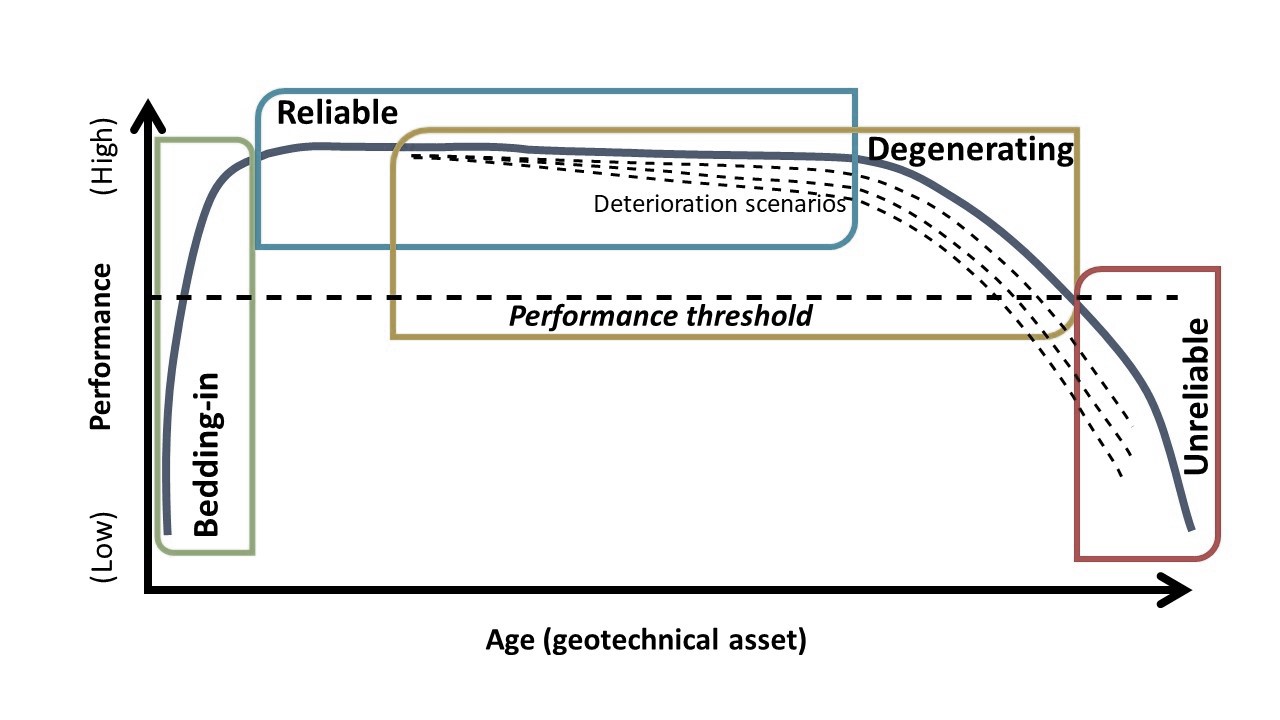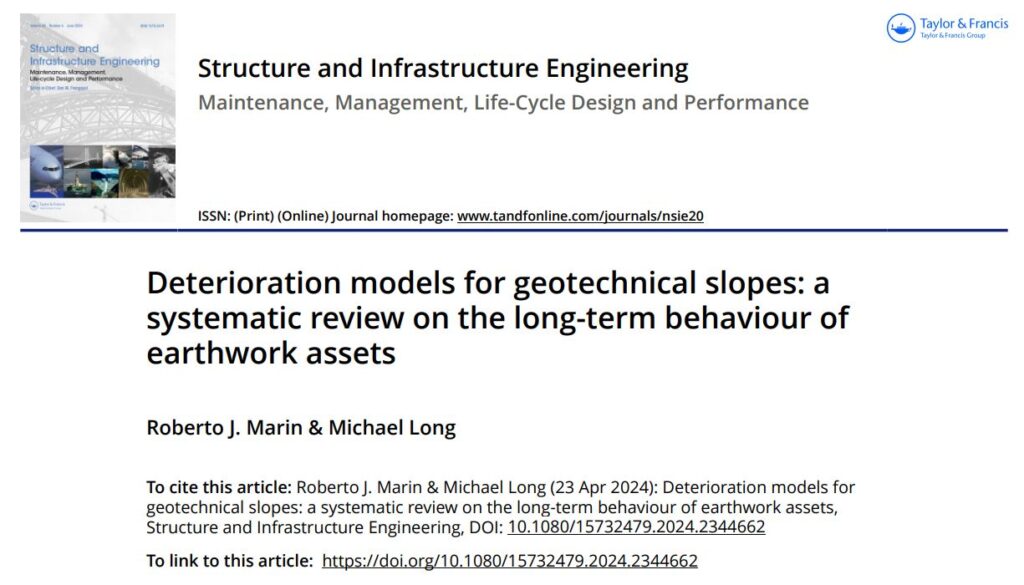Our systematic review delves into the enduring performance of geotechnical slopes, shedding light on crucial research gaps and proposing a strategic framework for analysis. While existing models are sparse, our review underscores the rising interest in understanding the mechanisms behind long-term asset behavior. By emphasizing the significance of monitoring and data collection, we pave the way for enhanced predictive capabilities and proactive maintenance strategies. Our proposed framework advocates for an integrated approach, combining laboratory experiments with field testing and simulations, to deepen our comprehension of soil behavior and develop robust deterioration models. In conclusion, our review serves as a vital stepping stone towards bolstering infrastructure resilience and guiding future research endeavors in this critical domain.
This is an Accepted Manuscript of an article published by Taylor & Francis in Structure and Infrastructure Engineering on April 24, 2024, available at https://doi.org/10.1080/15732479.2024.2344662
Full manuscript PDF: Accepted Manuscript (AM)
Deterioration models for geotechnical slopes: A systematic review on the long-term behaviour of earthwork assets
Roberto J. Marin 1, 2 *, Michael Long 2
1 Landslide Scientific Assessment, LandScient, Medellín, Colombia, https://landscient.com
2 School of Civil Engineering, University College Dublin, Newstead Building, Belfield, Dublin 4, Ireland.
*Author of correspondence: Roberto J. Marin, rjmarin@landscient.com, https://orcid.org/0000-0002-3206-0425
Michael Long, https://orcid.org/0000-0002-7053-4556
Abstract
Deteriorating infrastructure slopes have significant implications for infrastructure management, as their performance and long-term behaviour can impact travel, costs, safety, and operational efficiency. Understanding the long-term behaviour and performance of geotechnical assets is crucial for effective asset management and proactive maintenance. This systematic review examines existing research on deterioration models to identify methodologies, monitoring techniques, and data collection approaches employed to analyse the behaviour of geotechnical assets over time. The review emphasizes the importance of understanding asset deterioration mechanisms, particularly those influenced by weathering, and their impact on the overall performance and long-term behaviour of geotechnical assets. By consolidating knowledge from the scientific literature, this study highlights the limited availability of comprehensive deterioration models for earthwork slopes but identifies a growing interest in studying factors and mechanisms that contribute to understanding long-term asset behaviour. The review underscores the significance of monitoring, instrumentation, and data collection to enhance our understanding of geotechnical asset deterioration and improve predictive capabilities. Additionally, a proposed framework is introduced for long-term analysis of geotechnical assets, advocating combining lab and field tests for precise soil characterization and developing deterioration models. This systematic review deepens the understanding of asset deterioration mechanisms and aids in decision-making for infrastructure resilience.
Keywords: Deterioration mechanisms; Geotechnical Asset; Performance; Long-term behaviour; Earthwork Slope; Deterioration Model; Embankment; Cut slope
Summary (AI generated description of the research article)
Introduction: The management of deteriorating infrastructure slopes is vital for ensuring the efficiency, safety, and cost-effectiveness of transportation networks. Long-term behavior and performance analysis of geotechnical assets are pivotal for effective asset management and proactive maintenance. Our systematic review critically assesses existing research on deterioration models, methodologies, and monitoring techniques used to analyze the behavior of geotechnical assets over time. By consolidating insights from the scientific literature, we highlight the dearth of comprehensive deterioration models for earthwork slopes while noting a burgeoning interest in understanding long-term asset behavior.
Methods: Our systematic review aimed to identify and analyze research on the development of deterioration models for geotechnical assets, focusing on cut slopes and embankments. Following the PRISMA protocol, we addressed key research questions pertaining to the publication, study, monitoring, and data collection of deterioration models for earthwork slopes.
Data Analysis: Our analysis of 37 selected documents revealed a relatively low number of contributions to the development of deterioration models for earthwork slopes, reflecting the limited research in this area globally. We observed disparities in the distribution of research studies across countries, with notable projects like iSMART and Achilles in the UK driving advancements in this field.
Modelling Deterioration of Earthwork Slopes: While only a fraction of the selected documents presented geotechnical asset deterioration models, projects like iSMART and Achilles contributed significantly to this area. Numerical modeling within these projects focused on understanding climate-related factors and progressive failure mechanisms influenced by weather conditions and vegetation effects.
Discussion: Our review underscores the scarcity of comprehensive deterioration models for earthwork slopes in the scientific literature. However, we note a growing interest in studying factors and mechanisms contributing to long-term asset behavior. While our search strategy targeted deterioration models specifically, we acknowledge the potential of related studies to inform the development of such models.
A Basic Framework for Deterioration Models for Earthwork Slopes: Drawing from our comprehensive review, we propose a framework aimed at facilitating in-depth analysis of geotechnical asset behavior. This framework advocates for the integration of laboratory testing, field monitoring, and preliminary simulations to enhance understanding of soil behavior and develop reliable deterioration models specific to studied soils.
Conclusions: Our systematic literature review provides valuable insights into the current state of research on deterioration models for geotechnical slopes. While the availability of comprehensive models remains limited, there is a growing interest in this field. We emphasize the importance of continued research to develop comprehensive deterioration models tailored to earthwork slopes and highlight the significance of monitoring, instrumentation, and data collection in refining predictive capabilities. Our review serves as a foundational resource for infrastructure professionals and stakeholders, guiding future research directions in this critical domain.



